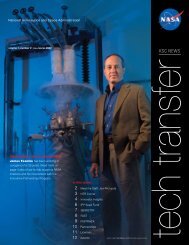2006-2007 - Kennedy Space Center Technology Transfer Office
2006-2007 - Kennedy Space Center Technology Transfer Office
2006-2007 - Kennedy Space Center Technology Transfer Office
- No tags were found...
You also want an ePaper? Increase the reach of your titles
YUMPU automatically turns print PDFs into web optimized ePapers that Google loves.
Electrostatic Characterization of Lunar Dust<strong>2006</strong> <strong>Center</strong> Director’s Discretionary Fund ProjectTo ensure the safety and success of future lunar exploration missions, it is important toLunar Launch/Landing Site measure the toxicity of the lunar dust and its electrostatic properties. The electrostaticEjecta Mitigation properties of lunar dust govern its behavior, from how the dust is deposited in anastronaut’s lungs to how it contaminates equipment surfaces. Astronaut Harry Schmidtsaid, “Dust is going to be the environmental problem for future missions, both inside and outside thehabitats.” NASA has identified the threat caused by lunar dust as one of the top two problems thatneed to be solved before returning to the Moon.The main reason lunar dust adheres to surfaces is its electrical charge, and the dry conditions on theMoon increase those adhesive properties. The Apollo 12 Mission Briefing report stated that “thecohesive properties of the lunar dust in vacuum, augmented by electrostatic properties, tend to makeit adhere to anything it contacts.”To understand the electrostatic nature of lunar dust, NASA must answer the following questions:(1) how much charge can accumulate on the dust? (2) how long will the charge remain? and(3) can the dust be removed? These questions can be answered by measuring the electrostaticproperties of the dust: its volume resistivity, charge decay, charge-to-mass ratio or chargeability, anddielectric properties. The volume resistivity of a material indicates the likelihood that the particleswill acquire a charge and their ability to dissipate the charge. Charge decay measurements give thetime it takes for samples to dissipate the applied charge. The charge-to-mass ratio (chargeability)measurements indicate the amount of charge the dust is likely to acquire during specific processes.The dielectric properties of the dust give a measure of the dust’s ability to polarize.All lunar dust samples that were returned to Earth have been contaminated by air. Thiscontamination most likely affected the electrostatic properties of the material through oxidation.The addition of oxygen atoms to the surface changes the surface chemistry, lowers the surface freeenergy, and changes the work function of the material. In many cases, these properties influencethe magnitude and sign of the charges exchanged between materials, which in turn influences theelectrostatic properties. These relationships illustrate the importance of measuring the electrostaticFigure 1. Schematic of the side profile of the design of the test cell usedthroughout the experiments.32 <strong>Space</strong>port Structures and Materials













